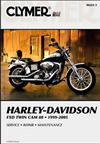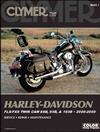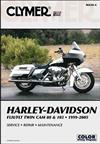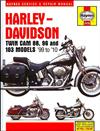Twin Cam Harley Davidson motorcycle workshop manual
The Harley-Davidson Twin Cam engines are motorcycle engines produced by Harley-Davidson since 1998.
The Twin Cam 88 premiered for the 1999 design season in September 1998.
The Twin Cam at first was not found in the Softail design families ahead of the
Harley Davidson FXD Twin Cam 88 1999-2005 Clymer Owners Service and Repair Manual

Softcover - 590 pages - Harley Davidson FXD Twin Cam 88 1999-2005 Clymer Owners Service Repair Manual Covers the following Models: FXD/FXDI Dyna Super Glide (1995-2005) FXDS-CONV Dyna Super Glide Convertible (1999-2000) FXDL/FXDLI Dyna Low Rider (1999-2005) FXDWG/FXDWGI Dyna Wide Glide (1999-2005) FXDX/FXDXI Dyna Super Glide Sport (1999-2005) FXDC/FXDCI Dyna Super Glide Custom (2005) FXDP Dyna Defender Police (2001-2004)Table of Contents: QUICK REFERENCE DATA GENERAL INFORMATIONManual organization / Warnings cautions and notes / Safety / Serial numbers / Fasteners / Shop supplies / Basic tools / Precision measuring tools / Electrical system fundamentals / Special tools / Basic service methods / Storage / Specifications TROUBLESHOOTINGOperating requirements / Starting the engine / Engine performance / Electric starting system / Charging system / Ignition system / Fuel system / Engine noises / Engine lubrication / Clutch / Transmission / Lighting system / Excessive vibration / Front suspension and steering / Brake problems LUBRICATION MAINTENANCE AND TUNE-UPRoutine safety checks / Maintenance intervals / Tyres and wheels / Per
Harley-Davidson FLS/FXS Twin Cam 88B, 95B and 103B 2000 - 2005Clymer Owners Service and Repair ...

Softcover - 554 pages - Harley-Davidson FLS/FXS Twin Cam 88B 95B and 103B 2000 - 2005 Service Repair Manual Covers the following Models: Harley FLSTC/FLSTCI Heritage Softail Classic 2000-2005 Harley FLSTF/FLSTFI Fat Boy 2000-2005 Harley FLSTFI Fat Boy 15th Anniversary Edition 2005 Harley FLSTFSE Screamin Eagle Fat Boy 2005 Harley FLSTS/FLSTSI Heritage Springer 2000-2004 Harley FLSTN/FLSTNI Softail Deluxe 2005 Harley FLSTSC/FLSTSCI Softail Springer Classic 2005 Harley FXST/FXSTI Softail Standard 2000-2005 Harley FXSTB/FXSTBI Night Train 2000-2005 Harley FXSTS/FXSTSI Springer Softail 2000-2005 Harley FXSTD/FXSTDI Softail Deuce 2000-2005 Harley FXSTDSE2 Screamin Eagle Deuce 2004Contents: QUICK REFERENCE DATA GENERAL INFORMATIONManual organization / Warnings cautions and notes / Safety / Serial numbers / Fasteners / Shop supplies / Basic tools / Special tools / Precision measuring tools / Electrical system fundamentals / Basic service methods / Storage / Specifications TROUBLESHOOTINGEngine principles / Oper
Harley-Davidson FLH, FLT Twin Cam 88 and 103 1999 - 2005Clymer Owners Service and Repair Manual

Softcover - 702 pages - Harley-Davidson FLH/FLT Twin Cam 88 103 1999 - 2005 Clymer Owners Service Repair Manual Covers the following Models: FLHT/FLHTI Electra Glide Standard (1999-2005) FLHTC/FLHTCI Electra Glide Classic (1999-2005) FLHTCUI Electra Glide Ultra Classic (1999-2005) FLHTCSE2 Screamin Eagle Electra Glide 2 (2005) FLHR/FLHRI Road King (1999-2005) FLHRCI Road King Classic (1999-2005) FLHRS/FLHRSI Road King Custom (2004-2005) FLTR/FLTRI Road Glide (1999-2005)Note: the quot;I quot; designation indicates fuel injected modelsContents: QUICK REFERENCE DATA GENERAL INFORMATIONManual organization / Warnings cautions and notes / Safety / Serial numbers / Fasteners / Shop supplies / Basic tools / Special tools / Precision measuring tools / Electrical system fundamentals / Basic service methods / Storage / Specifications TROUBLESHOOTINGOperating requirements / Engine starting / Engine performance / Starting system / Charging system / Ignition system / Engine management system diagnostic codes / Cruise control system diagnostic codes / Fuel system (carbureted models) / Fuel system (fuel injected models) / Engine noises / Engine lubrication / Cl
Harley-Davidson Twin Cam 88, 96 and 103 1999 - 2010Haynes Owners Service and Repair Manual

Softcover - 256 pages - Harley-Davidson Twin Cam 88 96 103 1999 - 2010 Haynes Owners Service Repair Manual Covers the following Models: Harley Softail all models 88 cid (1450cc) 2000 - 2006 Harley Softail all models 96 cid (1548cc) 2007 - 2010 Harley Dyna Glide all models 88 cid (1450cc) 1999 - 2006 Harley Dyna Glide all models 96 cid (1548cc) 2007 - 2010 Harley Touring all models 88 cid (1450cc) 1999 - 2006 Harley Touring all models 96 cid (1548cc) 2007 - 2010 Harley Touring all models 103 cid (1688cc) 2010Note: manual includes all Electra Glide Road King and Road Glide models.Contents: Maintenance Maintenance Sschedule and Procedures Engine Oil Level Check Brake Fluid Level Checks Tyre Checks Component Locations Repairs and Overhaul Engine Transmission and Associated Systems Clutch Primary Drive Fuel System and Lubricatio
The Twin Cam 88 premiered for the 1999 design season in September 1998. The Twin Cam 96 was released for 2007 model seasons.
The Twin Cam at first was not found in the Softail design families ahead of the seasons 2000. This was as a result of the chassis build and vibration transfer into Softail frame as a result of the direct mounting associated with motor. Dyna products is "rubber installed", damping many vibration transfer to your frame and rider. Another factor is your engine and transmission on a Twin Cam are right bolted together, using the chassis seat article on a Softail getting back in the way of a Twin Cam transmission circumstances. While the providers determined that a rubber-mounted Softail would affect the range's visual styling, Harley fixed the matter by creating an engine variation generally Twin Cam 88B. Its essentially the same motor once the initial, however with a modified engine block build that integrate twin chain-driven balance shafts. The Twin Cam 96B system premiered at precisely the same time because the Twin Cam 96A design, for 2007 model season, and was furnished on all Softail products until it had been replaced because of the 103 ci version.
You are able, but to attach a typical Twin Cam engine to a pre-2000 Softail, through third-party adapters.
The system design differed considerably from the predecessor the "Evo" although it provided some design elements utilizing the Sportster range. The 88 presents the displacement in cubic ins for the standard engine. The bore try 95.3 mm in addition to stroke try 101.6 mm, meaning the displacement was 88 cu in. The Twin Cam 96 displaces 96.7 cu in. The organization revealed 103 cu set for 2010 Electra Glide Ultra restricted brands, and later for 2012 Softail brands and 110 cu set for Screamin' Eagle/CVO brands.
Growth of the Twin Cam were only available in the first 1990s, as Harley needed to address troubles influencing the last development motor, particularly structural weaknesses in the crankcase, oil blood supply and leakages. While aftermarket organizations such as S&S period formerly responded with more powerful crankcase components for superior Evolutions, Harley gone for a completely new build, while maintaining the system basically and visually just like the conventional 45-degree, air-cooled overhead valve V-twin.
The Twin Cam only shared 18 section having its forerunner, as the vast majority of the components had been special towards motor. Given that name implies, the motor makes use of two chain-driven cams, to adhere to EPA sound laws. The drivetrain ended up being strengthened through an installing system known as the "Revised back Interface", enabling the transmission circumstances is installed straight to the trunk associated with engine, with the biggest drive and clutch covers playing less of a structural part; this is in addition partly the reason behind Softails not initially getting a Twin Cam the 1999 design 12 months.
The first prototype Twin Cam machines had substantial issues using the oiling program. These problems delayed launch of the system as scheduled when it comes to 1997 model seasons. Once the machines were run, oil came out any gasketed joint plus the breather. Harley looked for the aid of Paul Troxler, a new engineer from Southwest Studies Institute and eventually the issue is traced to a design which drained the cam case in to the crankcase, and utilized an individual scavenge pump. As a result of airflow through ports in the crankcase wall, the cam case wasn't draining precisely. After much assessment, the clear answer would be to secure the cam circumstances through the crankcase and make use of a dual scavenge system, which was integrated in to the engine, in the place of as an outboard pump as utilized on old gigantic Twins considering that the earliest Knucklehead. But oil ended up being nonetheless maybe not scavenging properly from the crankcase, and also this was tracked to an acoustic occurrence as a result of the quality of the scavenge inlet. Limiting the diameter regarding the inlet, a counter-intuitive solution, resolved that problem.
Because of the 1990s, the Evolution became a phenomenal motor and is a vital ingredient into revival of Harley's triumph. Although the Evo motor revitalized the charm, feel and rumble that made a Harley attractive, moreover it was saddled with design and manufacturing flaws, like crankcase damage, left-side situation leakages, weeping cylinder base gaskets and pulled cylinder studs. Early to mid-1990s Evo circumstances had been many susceptible to catastrophic tragedy. Creating an 80ci system beyond approximately 80 to 85hp aided by the very early '90s-style situation became high-risk at the best. That required that aftermarket components are needed to fix the Evo's design and production defects. The factory understood the Evo base end recommended a total redesign to really make it powerful enough to manage moderate customizations let alone severe efficiency services. Additionally, EPA regulations are dictating the elimination associated with the pressing and whining noises from the cam gears.
The factory's means to fix these problems was to create an engine that could not merely fix understood dilemmas additionally one which would bring Harley-Davidson later on and in to the upcoming. Easily put, an engine that don't drip, had room for efficiency prospective and pleased EPA laws while maintaining the standard 45-degree, V-twin, air-cooled and pushrod design. To satisfy the EPA's reduced sounds edicts, Harley made a decision to abandon the gear-driven cam build and replace it with a chain-driven system. But to keep up the original V-twin silhouette, Harley had to use a two-cam build. As records would prove, the newest engine became known as the Twin Cam, as the cam arrangement embodied the major distinction between this new motor and its forerunner, the Evo. The Twin Cam ended up being introduced in mid-1998 and delivered in 1999 rubber-mounted larger twins. Even though the Twin Cam design became the newest engine's namesake, in addition it became a source of ongoing problems and stress for all owners.
Cam Bolts & Drive Gears
Some most early 1999 TC systems had been plagued by damage of cam bolt holding down the big drive sprocket connected to the back cam. More 1999 versions encountered issues because the keyway on the rear camshaft drive sprocket sheared. The keyway is regularly secure the drive equipment towards the camshaft. The factory fixed those trouble by changing the defective hold-down bolt therefore the drive gear's cast-in keyway with several splines regarding the drive equipment and end regarding the camshaft.
Outboard Back Cam Bearings
A significant issue also created aided by the outboard backside cam bearing found in the cam support dish. At first, Twin Cam machines are made using two roller bearings to guide the twin camshafts in the right side. As a result of the way a corner ball bearing is subjected to causes, they usually unsuccessful. The factory supposedly fixed the problem in late 2000 by upgrading the cam assistance dish and changing the ball-bearing when it comes to back camshaft with a roller bearing. Leading cam retained a ball bearing for outboard help. A service bulletin ended up being issued by the factory in July 2000 describing the fix. Currently, at least four cam support dish designs have already been made use of, so you must make sure you have the correct support plate when doing any upgrades.
Inboard INA Cam Bearings
Another cam bearing many motor builders feeling uncomfortable operating is the INA bearing used to offer the Twin Cam's two camshafts regarding the remaining part or inboard part. The INA bearings are found inside right-side crankcase just over the crank's big pinion bearing. Harley experimented by utilizing INA bearings rather than Torringtons on a few Shovelhead versions after which transformed completely to your INA because of the advancement. INA bearings have actually intermittently caused difficulties whenever utilized on the left region of the V-twin's camshaft. As such, smart system builders change the INA bearing with a B-148 Torrington.
Chain-Driven Cams
Various other severe issues involve the quiet cam stores that drive the camshafts and spring-loaded tensioners always keep consitently the stores in modification. The 1999 to 2006 Twin Cam motors, except those delivered with all the 2006 Dyna products, utilize two quiet stores and two spring-loaded adjusters. There are lots of difficulties with this setup, both for inventory and performance-modified motors.
To cut back cam gear whine, the Twin Cam's timing setup makes use of quiet stores and drive sprockets instead of the old-fashioned spur-gear drive system. The Twin Cam's quiet chains were made of six plates lined up alongside. This leads to an inverted enamel or "hushed" sort of timing sequence that provides a smooth and fairly peaceful device. Silent chains aren't anything brand-new but already been utilized by Detroit automakers for a long period. Although silent stores tend to be hushed, in addition they stretch, causing incorrect timing. This is exactly why, automotive hot rodders have traditionally enhanced silent timing stores with roller chains, that are less heavy, more durable and may manage higher rpm.
Additionally, most superior webcams need higher valve spring pressures to manage valve float and jump. Greater valve spring stress places higher loads from the camshaft, leading to better needs in the stock spring-loaded string tensioners. Consequently, the spring tensioners being overloaded, leading to a loose time sequence and inaccurate cam time. Studies prove that build of the stock hushed string and spring-loaded tensioner apparatus allows cam timing to vary whenever 4 degrees and a lot more whenever hefty device springs are employed.
Another problem of spring-loaded tensioners is early use associated with tensioner shields. Silent stores have razor-sharp edges, causing rapid use for the pads. Particles through the tensioner shields circulates aided by the motor oils and can score components and clog tiny orifices. Pad debris was known to clog up a piston oiler, holding the check basketball open. The end result are reduced oil stress, ticking lifters, oil puking and a number of various other difficulties. To slow tensioner pad wear, some system designers has resorted to polishing the outside edges of both quiet chains. But this is best a Band-Aid answer.
Turning Crankshaft
A significant Twin Cam difficulties that's seldom discussed try crankshaft shifting. Under hard deceleration, acceleration or burnouts, the Twin Cam's pressed-together crankshaft can twist out-of true, sometimes up to .030 inch or higher in worst conditions. An ideally trued crank ought to be trued to within .001 inches. A crank seriously regarding real trigger the termination of the pinion shaft to wobble severely. Early-warning indications tend to be loud noises from the system's gearcase area, ticking lifters and oils puking from the breathers. The result is catastrophic damage to the oils pump and losing oils pressure and scavenging. For beginners, the crank, oils pump, camshafts, cam help dish and cam drive mechanism want replacement. In addition, debris through the damaged components circulates through the system, trashing cylinder wall space, pistons, lifters and anything else with its course. The oils tank also ultimately ends up contaminated and requires cleansing. If you're on guarantee, you may be lucky enough for a replacement motor, hardly ever really knowing what precisely gone wrong or the reason why it gone wrong. Nevertheless issue is prepared to bite your once again, because your brand new engine has the same defects once the old, damaged system. Alternatively, if you're the unfortunate people, you receive a large restoration bill.
Some Achilles' Heel Repairs
There are lots of fixes for the formerly explained dilemmas. Initially, all the early Twin Cam motors with potential cam bolt damage and drive equipment keyway shearing difficulties should have already been set. The fixes were easy, nevertheless have to remove the gearcase address to examine the problematic parts. Second, ensure that your system has a roller bearing set up in the cam help plate when it comes to rear cam. The roller bearing is easily distinguishable through the ball bearing utilized for leading cam. Additionally, anytime employed inside cam gearcase, check out the inboard cam bearings. For those who have the stock INA bearings, exchange all of them with confirmed Torrington B-148 bearings.
The very best yet most expensive means for eliminating all silent string and spring-loaded tensioner difficulties should install a couple of gear-driven cameras. Andrews goods and S&S; period provide gear-drive webcams. Gear-drive cams will create more accurate cam timing while getting rid of the architectural weakness of cam's drive program. But make sure to check out the cam gears for correct clearance. A too-tight fit will emit a whine or destroy the gears in 1000 or so kilometers. A loose fit will result in gear clatter.
Harley-Davidson updated the quiet sequence and spring-loaded tensioner apparatus with a roller sequence and hydraulic tensioner setup in 2006 on Dyna models plus 2007 for all various other designs. This cam drive system try better than the hushed chain build. The roller chains require yet another sprocket design than quiet stores, in addition to tensioner shields happen changed with plastic. However, I have observed one engine where in actuality the brand-new nylon shields had been worn-out in about 20,000 miles. The baseball and roller bearings in cam help plate have also been eliminated, leaving the camshafts driving on the assistance dish. Just time will inform how well this build works. Andrews Products offers a conversion system to update 1999 to 2005 silent chain Twin Cams to roller chain drive.
Eventually, not all cranks leave true and bring catastrophic system problems. Though it is apparently a hit-and-miss idea, stock cranks appear to be more prone to trouble, although We have observed some aftermarket cranks twist. The repair for eliminating a twisting crank is to begin with a great crank, TIG-weld the crankpin on both finishes after which retrue the crank. The photos show Quick Block Charlie TIG-welding the crankpin on a stock factory 43/8-inch stroker crank. Installing a Timken bearing regarding crankcase left side-on 2003-and-newer products normally a wise improvement to aid lessen crank perspective.
The classic Harley-Davidson motors is V-twin motors, with a 45° perspective between your cylinders. The crankshaft possess just one pin, and both pistons were attached to this pin through their connecting rods.
This 45° position are covered under a few United States patents and it is an engineering tradeoff that enables a sizable, high-torque engine in a relatively smaller space. They produces the cylinders to fire at uneven periods and brings the choppy "potato-potato" sound so strongly for this Harley-Davidson brand name.
To streamline the engine and lower outlay, the V-twin ignition ended up being designed to run with an individual set of things no provider. This will be known as a dual fire ignition program, causing both spark plugs to fire irrespective of which cylinder had been on their compression stroke, utilizing the other spark-plug firing on their cylinder's exhaust swing, successfully "wasting a spark". The exhaust note is simply a throaty growling sound with a few popping. The 45° design associated with the motor thus brings a plug firing sequencing therefore: the initial cylinder fires, the 2nd cylinder fires 315° later on, then there is a 405° gap through to the very first cylinder fires once more, offering the system their unique noise.
Harley-Davidson have utilized numerous ignition systems throughout their record – become they the first things and condenser system,, magneto ignition program applied to some 1958 to 1969 Sportsters, early electric with centrifugal mechanical advance weights,, or the late digital with transistorized ignition controls component, more familiarly referred to as black field or even the brain,.
Beginning in 1995, the organization launched Electronic gas injections as a choice when it comes to 30th anniversary version Electra Glide. EFI became standard on all Harley-Davidson motorbikes, including Sportsters, upon the development of the 2007 products.
In 1991, Harley-Davidson started initially to be involved in the Sound Quality performing Group, launched by Orfield Labs, Bruel and Kjaer, TEAC, Yamaha, Sennheiser, SMS and Cortex. This was the country's earliest team to fairly share research on mental acoustics. Later on that season, Harley-Davidson participated in some audio quality scientific studies at Orfield Labs, according to recordings taken at Talladega Superspeedway, with the objective to lessen the sound-level for EU requirements while analytically recording the "Harley noise". This study resulted in the bikes that were launched in conformity with EU specifications for 1998.
On February 1, 1994, the company recorded an audio trademark application for distinctive sound for the Harley-Davidson motorcycle system: "The mark is made of the exhaust noise of applicant's motorbikes, from V-twin, common crankpin bike engines if the items come in utilize". Nine of Harley-Davidson's competitors recorded responses opposing the program, arguing that cruiser-style motorbikes of numerous companies utilize a single-crankpin V-twin engine which emit an equivalent noise. These objections are followed closely by litigation. In June 2000, the company dropped efforts to federally subscribe its trademark.